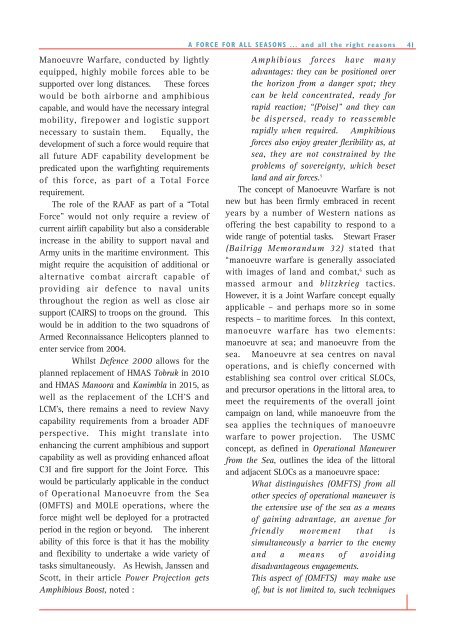ISSUE 150 : Sep/Oct - 2001 - Australian Defence Force Journal
ISSUE 150 : Sep/Oct - 2001 - Australian Defence Force Journal
ISSUE 150 : Sep/Oct - 2001 - Australian Defence Force Journal
You also want an ePaper? Increase the reach of your titles
YUMPU automatically turns print PDFs into web optimized ePapers that Google loves.
Manoeuvre Warfare, conducted by lightlyequipped, highly mobile forces able to besupported over long distances. These forceswould be both airborne and amphibiouscapable, and would have the necessary integralmobility, firepower and logistic supportnecessary to sustain them. Equally, thedevelopment of such a force would require thatall future ADF capability development bepredicated upon the warfighting requirementsof this force, as part of a Total <strong>Force</strong>requirement.The role of the RAAF as part of a “Total<strong>Force</strong>” would not only require a review ofcurrent airlift capability but also a considerableincrease in the ability to support naval andArmy units in the maritime environment. Thismight require the acquisition of additional oralternative combat aircraft capable ofproviding air defence to naval unitsthroughout the region as well as close airsupport (CAIRS) to troops on the ground. Thiswould be in addition to the two squadrons ofArmed Reconnaissance Helicopters planned toenter service from 2004.Whilst <strong>Defence</strong> 2000 allows for theplanned replacement of HMAS Tobruk in 2010and HMAS Manoora and Kanimbla in 2015, aswell as the replacement of the LCH’S andLCM’s, there remains a need to review Navycapability requirements from a broader ADFperspective. This might translate intoenhancing the current amphibious and supportcapability as well as providing enhanced afloatC3I and fire support for the Joint <strong>Force</strong>. Thiswould be particularly applicable in the conductof Operational Manoeuvre from the Sea(OMFTS) and MOLE operations, where theforce might well be deployed for a protractedperiod in the region or beyond. The inherentability of this force is that it has the mobilityand flexibility to undertake a wide variety oftasks simultaneously. As Hewish, Janssen andScott, in their article Power Projection getsAmphibious Boost, noted :A FORCE FOR ALL SEASONS ... and all the right reasons 41Amphibious forces have manyadvantages: they can be positioned overthe horizon from a danger spot; theycan be held concentrated, ready forrapid reaction; “(Poise)” and they canbe dispersed, ready to reassemblerapidly when required. Amphibiousforces also enjoy greater flexibility as, atsea, they are not constrained by theproblems of sovereignty, which besetland and air forces. 5The concept of Manoeuvre Warfare is notnew but has been firmly embraced in recentyears by a number of Western nations asoffering the best capability to respond to awide range of potential tasks. Stewart Fraser(Bailrigg Memorandum 32) stated that“manoeuvre warfare is generally associatedwith images of land and combat, 6 such asmassed armour and blitzkrieg tactics.However, it is a Joint Warfare concept equallyapplicable – and perhaps more so in somerespects – to maritime forces. In this context,manoeuvre warfare has two elements:manoeuvre at sea; and manoeuvre from thesea. Manoeuvre at sea centres on navaloperations, and is chiefly concerned withestablishing sea control over critical SLOCs,and precursor operations in the littoral area, tomeet the requirements of the overall jointcampaign on land, while manoeuvre from thesea applies the techniques of manoeuvrewarfare to power projection. The USMCconcept, as defined in Operational Maneuverfrom the Sea, outlines the idea of the littoraland adjacent SLOCs as a manoeuvre space:What distinguishes (OMFTS) from allother species of operational maneuver isthe extensive use of the sea as a meansof gaining advantage, an avenue forfriendly movement that issimultaneously a barrier to the enemyand a means of avoidingdisadvantageous engagements.This aspect of (OMFTS) may make useof, but is not limited to, such techniques
















